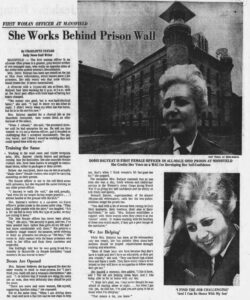First Woman Officer at Mansfield
FIRST WOMAN OFFICER AT MANSFIELD
She Works Behind Prison Wall
By: Charlotte Taylor
MANSFIELD – The first woman officer in an all-male Ohio prison is a genteel, gray-haired mother of two teenaged sons, who walks on opposite sides of the street from ardent women’s liberationists.
Mrs. Doris Balyeat has been one month on the job at Ohio State Reformatory, which houses some 2,300 prisoners. Her only worry was that male officers would resent her. It never materialized.
A divorcee with a 14-year-old son at home, Mrs. Balyeat had been working the 11 p.m. to 7 a.m. shift at the local post office with little hope of having her hours changed.
“The money was good, but it was hard physical labor,” she said. “I had to leave my son alone at night. I didn’t worry when my other son was home, but he is in the service now.”
Mrs. Balyeat applied for a clerical job at the Mansfield Institution, then turned down an offer because of the salary.
“When I refused,” she said, “the personnel director said he had a surprise for me. He told me the wanted to try out a woman officer, and it sounded so challenging that I accepted immediately. They pay was better, and I knew I would be working days and could spend time with my son.”
Training the Same
Working in the mail room and visitor reception area, Mrs. Balyeat checks letters and packages coming into the institution. She also searches female visitors who have been known to smuggle in contraband items, either in packages or their purses.
Before she was hired, there was no one to actually “shake down” female visitors who might be carrying something on their person.
The female officer is not in the cell block areas with prisoners, but she required the same training as any other prison officer.
“I learned to walk the wall,” she said, proudly “and even hit my target during target practice. . . I almost landed on the ground with the kick.”
Mrs. Balyeat’s uniform is a cut-down Air Force officers jacket made in the prison tailor shop. “They had a little trouble with the skirt,” she laughed. “It’s a bit too full to wear with this type of jacket, so they are cutting it down.”
The lone female officer has never been afraid. “One,” she says, “The security is good, and two, I’ve been around boys rather than girls all mt life and I feel more comfortable with them.” She projects a motherly image toward the inmates never referring to them as prisoners but always as “the boys.” She comes in daily contact with the honor prisoners who work in her office and finds them courteous and respectful.
One kiddingly told her he was going to ask for a transfer to Marysville (a female institution) “since women’s lib has moved in here.”
Doors Are Opened
Mrs. Balyeat believes she has opened the door for other women to work in the male prisons, but “I don’t think you could call me a woman’s liberationist,” she said. “I do believe that if women are doing the same job as men, then very definitely they should be paid the same.
“There are more and more women like myself, supporting families today,” she reasoned.
But at the same time, “When I am driving down the road and have a flat tire and no one stops to help me, that’s when I think women’s lib has gone too far,” she quipped.
The outspoken Mrs. Balyeat contends that at one time she was a shy, timid woman and credits her service in the Women’s Army Corps during World War II as giving her self-confidence and the ability to talk freely and openly.
Bernard Barton, superintendent of the almost 100-year-old Reformatory, calls her the best public relations image the prison has.
“You deal with a lot of women here coming to visit their husbands, their brothers, their sons or their boyfriends,” he said. “Mrs. Balyeat establishes a rapport with these women when they check in at the visitor’s center. It makes working with the families of these men much easier, if they get a good image of the institution.”
‘We Are Helping’
While Mrs. Balyeat has been at the Reformatory only one month, she has definite ideas about how inmates should be helped: rehabilitation through training and education.
“Most of these boys are here because they don’t have a trade and don’t have an education, so they get into trouble,” she said. “They can finish high school here and learn a trade, they have every chance to be helped so they will have an occupation to follow when they get out.”
She paused for a moment, then added, “I like it here, and I feel we are helping these boys. And I like being able to be at home with my son.
“I think he’s glad too, I had never thought he was afraid of staying alone at night. . . but when I got this job he told me, ‘I’m glad you are going to be at home when I’m sleeping.’
“That means a lot, you know.”
